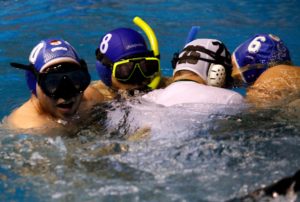During fastbreaks it is easy for a player to suffer tunnel vision, but the habit of swimming like a backstroker prevents surprises.
In an international friendly in Lund back in 2015, a German player left his own basket on the bottom after a Swedish turnover. Sprinting hard, the German lay on his back. He had cranked up the speed, but not to the extent that he was only focused on winning the race to the other side. The pool was 5 brutal meters deep. Timing dives was critical. At about the 2/3 mark a Swede diving from the surface approached the ball holder. Suddenly the German stopped and spun so that he had his fins up in defense.
Without resorting to any grappling the German shoved the Swede back up with his feet. Once the defensive player’s downward momentum was entirely halted. The German returned to his original swimming position and resumed his sprint towards the basket. It was elegant to see an elite player so completely neutralize the threat of another elite player at so little cost of energy.
The feet up defense is a neat trick. But it can be simpler. The player who sees the opponent can also accelerate away. If the ball holder estimates the opponent’s planned spot for intersection, he can leave that line. The straight line to the basket is the easiest for the defender to counteract. The player looking upwards can take this advantage away.
Forechecking from the blind angle gives the defensive player good chances to strip the ball or tackle. By swimming like a backstroke swimmer coming on the wall with just enough space for the dolphin kick below, most of the blind spots disappear.
Last but not least, the player who is looking can also see teammates coming to help.
The more you see, the better your decisions.
Originally posted on Davrell Tien’s page: UWRugby.org.


